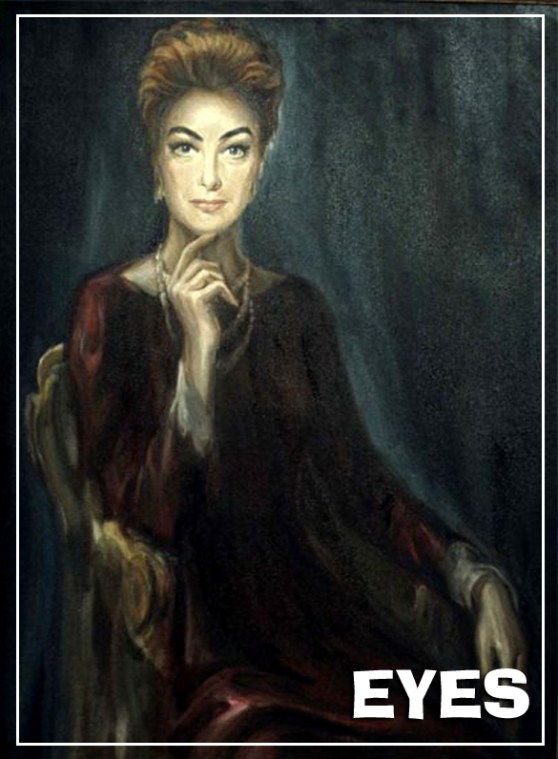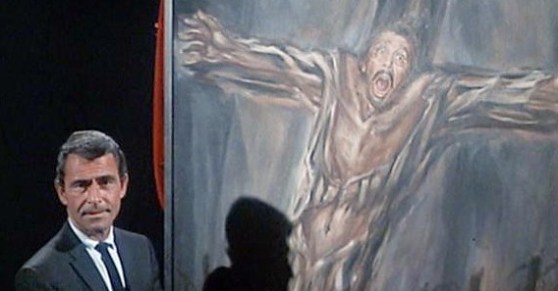There’s never been a better TV anthology — when it’s firing on all gears, that is — than Night Gallery. Sure, The Twilight Zone is a classic, but there are moments on this show that are still terrifying nearly fifty years later.
I remember as a kid I had a book called The TV Guide Book of Lists that I devoured. I kept coming back — and being afraid — of a list by Anton LaVey that inscribed the ten most Satanic TV shows of all time. Night Gallery was all over that list and for good reason. This show lives up to the quasi-religion he set forth on Walpurgisnacht, April 30, 1966.
“Good evening, and welcome to a private showing of three paintings, displayed here for the first time. Each is a collector’s item in its own way—not because of any special artistic quality, but because each captures on a canvas, suspended in time and space, a frozen moment of a nightmare.”
With those words, host Rod Serling would walk out of a gallery filled with paintings by Thomas J. Wright and Jaroslav “Jerry” Gebr. He created the series along with Jack Laird and one of the reasons why this show isn’t seen in the same light as The Twilight Zone is because Laird loved goofy humor in his horror, so there are “blackout” sketches interspersed throughout the show. Serling hated those scenes with a passion, saying “I thought they distorted the thread of what we were trying to do on Night Gallery. I don’t think one can show Edgar Allan Poe and then come back with Flip Wilson for 34 seconds. I just don’t think they fit.”
The show was part of a rotating anthology series called Four in One. This 1970–1971 television series rotated four separate shows, including McCloud, SFX (San Francisco International Airport) and The Psychiatrist. Only McCloud and Night Gallery were renewed and became full series for the 1971-1972 season.
One of the other reasons why this show isn’t held in higher esteem is because so many people never saw it in its original form. In order to increase the number of episodes that were available for syndication, the 60-minute episodes were re-edited for a 30-minute time slot, with many segments severely cut and changed, along with extended new scenes using cut or stock footage. Then, in an even greater indignity, twenty-five episodes of the Gary Collins-starring series The Sixth Sense were added to the syndicated version with Serling filming newly filmed introductions. That show was also an hour originally, so that means that they were also edited into oblivion.

Premiering on NBC on November 8, 1969, Night Gallery began with three stories and aired as a TV movie. “Eyes” and “The Escape Route” are based upon novellas Rod Serling wrote for the book The Season to Be Wary in 1967.
 Serling starts the series by stating “Good evening, and welcome to a private showing of three paintings, displayed here for the first time. Each is a collector’s item in its own way—not because of any special artistic quality, but because each captures on a canvas, suspends in time and space, a frozen moment of a nightmare. Our initial offering: a small gothic item in blacks and grays, a piece of the past known as the family crypt. This one we call, simply, “The Cemetery.” Offered to you now, six feet of earth and all that it contains. Ladies and gentlemen, this is the Night Gallery…”
Serling starts the series by stating “Good evening, and welcome to a private showing of three paintings, displayed here for the first time. Each is a collector’s item in its own way—not because of any special artistic quality, but because each captures on a canvas, suspends in time and space, a frozen moment of a nightmare. Our initial offering: a small gothic item in blacks and grays, a piece of the past known as the family crypt. This one we call, simply, “The Cemetery.” Offered to you now, six feet of earth and all that it contains. Ladies and gentlemen, this is the Night Gallery…”
Directed by Boris Sagal (who died when he literally walked the wrong way into a helicopter blade while filming the TV miniseries World War III), “The Cemetery” was written by Serling. It stars Roddy McDowell as Jeremy Evans as a man who murders his uncle to inherit his money and also gains the services of that man’s loyal — and now enraged — butler Osmond Portifoy (Ossie Davis). The effective terror within this episode is achieved with a painting of the family grave that keeps changing, along with great cinematography, editing and sound design that tells us that something undead — maybe — is coming for Jeremy. His last words, “What in God’s name is happening?”, are actually voiced by John Badham in an overdub.

“Eyes” starts with this narration: “Objet d’art number two: a portrait. Its subject, Miss Claudia Menlo, a blind queen who reigns in a carpeted penthouse on Fifth Avenue—an imperious, predatory dowager who will soon find a darkness blacker than blindness. This is her story…”
This was the directorial debut of 22-year-old Steven Spielberg, as well as one of the last acting performances by screen legend Joan Crawford. When she discovered that the young Spielberg would be directing her, Crawford called Sid Sheinberg, vice president of production for Universal Television, to demand that he be replaced but he talked her into taking a chance on him.
Despite her early reservations, the director and star got along well and stayed in touch until her death in 1977. In fact, before filming, she gave a speech to the crew informing them that she had worked with Spielberg previously and asked them to treat him with the same respect they would garner for an older and more seasoned, director.
Crawford would later say that she loved Rod Serling and his writing, yet remembered that “…his dialogue was the hardest to memorize. There’s a rhythm to his words and if you change one of them, the rhythm is off and you can’t remember.”
She plays Claudia Menlo, a rich woman who has received the eyes of a gambler through loan sharks and has blackmailed Dr. Frank Heatherton (Barry Sullivan) into a surgery that will give her sight for just one day. Surrounded by all of her favorite possessions, she doesn’t realize that a blackout is about to come for New York City.

Finally, “The Escape Route,” directed by Barry Shear, begins with this speech: “And now, the final painting. The last of our exhibit has to do with one Joseph Strobe, a Nazi war criminal hiding in South America—a monster who wanted to be a fisherman. This is his story…”
Richard Kiley is Joseph Strobe, a former German soldier on the run after World War II. He makes his way to a museum much like the night gallery that Serling occupies for the series. He speaks to a concentration camp survivor named Bleum (Sam Jaffe) and soon realizes that he was once in charge of the life and death of Bleum’s friends and family. Strobe finds peace in the museum, pulling himself into a dream of fishing through one of the paintings. The next day, Bleum recognizes Strobe, who kills him and must run again from authorities, finally coming back to the gallery and seeking the fisherman painting only to find his horrible final judgment within a painting of a crucified man.
In case you haven’t picked it up yet, I love this show. Between its strange electronic theme — which is different in the original pilot — and the fact that there’s a painting for each story, this has a look and feel unlike any series. Well, except for Guillermo del Toro’s Cabinet of Curiousities, which is directly influenced by this show.

If you love Night Gallery, without reservation I recommend Rod Serling’s Night Gallery: An After-Hours Tour by Scott Skelton and Jim Benson.

Skelton and Benson also created The Art of Darkness, which collects and speaks on all of the paintings used for the show. Sadly, both books are now out of print and quite expensive.
You can get the best quality version of this series from Kino Lorber, who have blu ray sets available of season 1, season 2 and season 3. I still have the gigantic DVD sets that came out for the show and these are a marked improvement on this already awesome collections.
I’m looking forward to writing about each episode in season one. What’s your favorite episode?